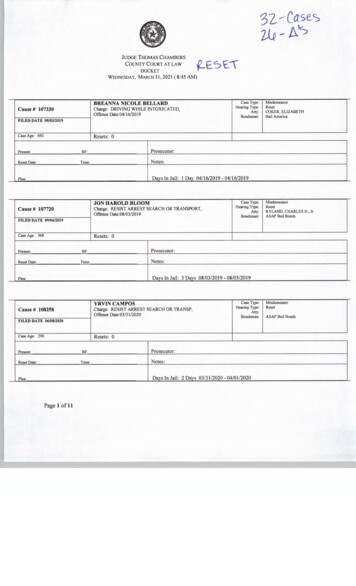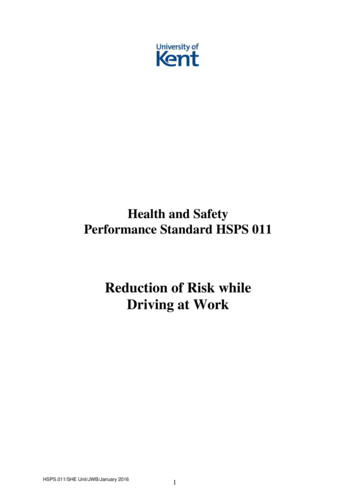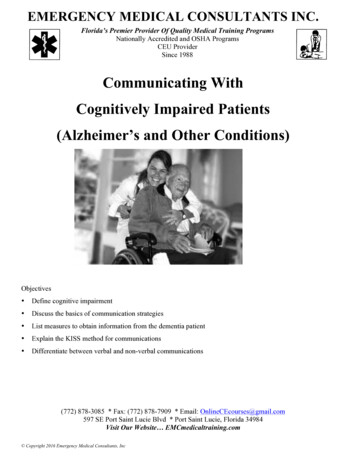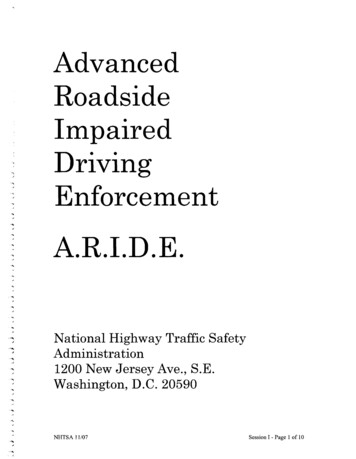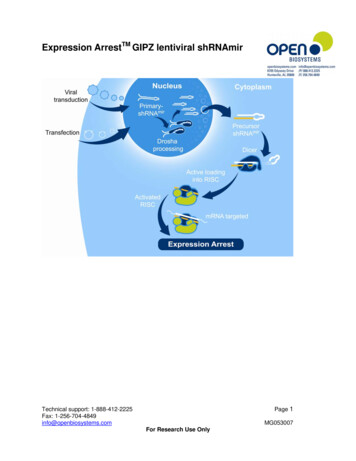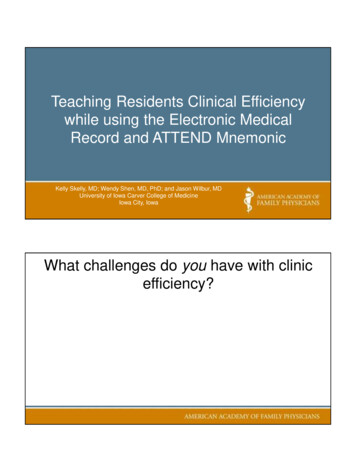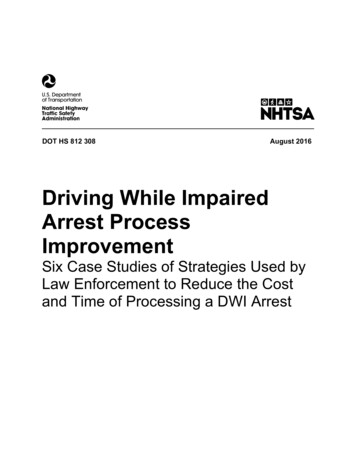
Transcription
DOT HS 812 308Driving While ImpairedArrest ProcessImprovementAugust 2016Six Case Studies of Strategies Used byLaw Enforcement to Reduce the Costand Time of Processing a DWI Arrest
DISCLAIMERThis publication is distributed by the U.S. Department of Transportation, NationalHighway Traffic Safety Administration, in the interest of information exchange.The opinions, findings, and conclusions expressed in this publication are those ofthe authors and not necessarily those of the Department of Transportation or theNational Highway Traffic Safety Administration. The United States Governmentassumes no liability for its contents or use thereof. If trade names, manufacturers’names, or specific products are mentioned, it is because they are consideredessential to the object of the publication and should not be construed as anendorsement. The United States Government does not endorse products ormanufacturers.Suggested APA Format Citation:Vanlaar, W., Brown, S., Ireland, L., & Robertson, R. (2016, August). Driving while impairedarrest process improvement: Six case studies of strategies used by law enforcement toreduce the cost and time of processing a DWI arrest (Report No. DOT HS 812 308).Washington, DC: National Highway Traffic Safety Administration.
Technical Report Documentation Page1. Report No.2. Government Accession No.DOT HS 812 3083. Recipient’s Catalog No.4. Title and Subtitle5. Report DateDriving While Impaired Arrest Process Improvement: Six Case Studiesof Strategies Used by Law Enforcement to Reduce the Cost and Timeof Processing a DWI ArrestAugust 20167. Author(s)8. Performing OrganizationReport No.9. Performing Organization Name and Address10. Work Unit No. (TRAIS)171 Nepean St., Suite 200Ottawa, ON K2P 0B411. Contract or Grant No.DTNH22-11-D-00222/000312. Sponsoring Agency Name and Address13. Type of Report and PeriodCoveredWard Vanlaar, Steve Brown, Leanna Ireland, and Robyn RobertsonTraffic Injury Research FoundationNational Highway Traffic Safety AdministrationOffice of Traffic Injury Control1200 New Jersey Avenue SE.Washington, DC 205906. Performing OrganizationCodeFinal Report14. Sponsoring Agency Code15. Supplementary NotesCaroline Cash was the Contracting Officer’s Representative (COR) for this project.16. AbstractThis final report of the Driving While Impaired Arrest Process project includes sixcase studies of strategies used by law enforcement to reduce the cost and timeof processing DWI arrests. The objectives of this study are to identify lawenforcement agencies that have made improvements to their DWI arrestprocedures that have resulted in time and/or cost savings, and gather data fromthese jurisdictions to describe any such savings experienced as a result of theseimprovements. The improvements, their resulting time and cost savings, as wellas experiences regarding the implementation of these improvements aredescribed in this report and used to inform the development of a roadmap thatother agencies can rely upon if they are interested in implementing these typesof solutions.17. Key Words18. Distribution StatementImpaired driving, DWI, DUI, OUI, BAC, arrestprocess, technology, roadmap, automation19. Security Classif. (of this report)UnclassifiedForm DOT F 1700.7 (8-72)Document is available to the public from theNational Technical Information Servicewww.ntis.gov20. Security Classif. (of this page)21. No. of Pages62Reproduction of completed page authorizedi
AcknowledgmentsThe Traffic Injury Research Foundation acknowledges the support provided by Westat, Inc., asthe prime contractor for this Indefinite Delivery/Indefinite Quantity (IDIQ) contract.TIRF thanks Lt. Johnny Poulos, director, Public Affairs Division of the Mississippi HighwayPatrol, for critically reviewing the discussion guide that was used by the research team during thedata collection phase of this project; the feedback received helped us improve this data collectioninstrument.Finally, TIRF also acknowledges the participation and assistance of the following agencies thatsupported this project focused on improving the DWI process. Austin Police Department Fresno Police Department Louisiana Highway Safety Commission Minnesota Department of Public Safety Nassau District Attorney’s Vehicular Crimes Bureau Salt Lake County District Attorney’s Office Salt Lake City Police Department Texas Department of Transportation Utah Prosecution Council Utah Bureau of Criminal Identification Utah Bureau of Forensic Toxicology Washington State Patrolii
Executive SummaryThe time required for law enforcement officers to complete a driving while impaired1 (DWI)arrest can be substantial. Therefore, the objectives of this study were to identify law enforcementagencies that have made significant improvements to their DWI arrest procedures and to describeany of the resulting cost and/or time savings. The goals of this study are to: Determine what strategies law enforcement agencies are using to reduce the costand/or time of processing a DWI arrest;Identify law enforcement agencies that have made such improvements;Gather data to describe and quantify the cost and/or time savings associated withthese processes;Capture the experiences of States/local agencies in undertaking these improvements;andCombine these results into a report that assists other agencies in adopting thesestrategies.Interviews were conducted from March to August 2015 with representatives of the followingagencies: California – Fresno Police Department;Louisiana – Louisiana Highway Safety Commission;Minnesota – Minnesota Office of Traffic Safety, Minnesota State Patrol;Texas – Texas Department of Transportation, Austin Police Department;Utah – Utah Attorney General; andWashington – Washington State Patrol.Based upon the information obtained during these interviews, we documented the followingapproaches to reducing time and/or costs associated with a DWI arrest:1 ECitation, Fresno, California Police Department: The Fresno Police Departmentimplemented the eCitation program, which consists of using electronic ticket writersand a software program to issue citations. The system has an auto-populate functionto avoid the entry of the same data multiple times and can validate data upon entryinto the system. Due to cost and time savings, the Fresno Police Department nolonger needs to rely on the 10 data entry clerks they previously required to managethe paper forms. LADRIVING, Louisiana: LADRIVING is an automated DWI citation processingsystem that is designed to streamline the way that DWI arrests are recorded inThe abbreviation DWI (driving while impaired or intoxicated) is used throughout this report as a convenientdescriptive label and to create consistency, even though some States use other terms such as OWI (operatingwhile impaired or intoxicated) or DUI (driving under the influence), and in some States these terms refer todifferent levels of severity of the offense.iii
Louisiana. LADRIVING offers a standardized electronic interface that enables allLouisiana law enforcement officers to enter, process, review, approve, query, andreport DWI arrest data on a standardized form. LADRIVING has reduced the lengthof the arrest process by approximately 50 percent. Previously, it took officers 5-6hours to process one arrest. Officers using LADRIVING can complete this task inhalf the time or in as little as 2 hours, depending on the proficiency level of thearresting officer. ECharging, Minnesota: Minnesota implemented eCharging as an electronic citationsystem with the intention of simplifying the entire DWI arrest process given thecomplexity of the DWI statute. In addition, the system provides web-based trainingfor breath test instrument operators. The system is comprehensive and capitalizes onthe automation of different steps of the DWI arrest process, such as determining thenumber of prior DWI convictions according to State Statutes. Previously, it took 1 to3 hours for the officers to fill out forms that can now be completed in as little as 9minutes. ECharging not only saves time in the field for the arresting officer but italso reduces the time that records managers at the Department of Vehicles andServices spend on cases. It was reported that records staff previously took 20minutes to enter information related to a DWI arrest; presently this time has beenreduced to approximately 4 minutes on average. EWarrant, Utah: The eWarrant electronic system makes the process of requesting awarrant to obtain a blood sample from a judge more efficient. When officers log in tothe system to request such a warrant, they use a unique ID, which pulls up fields thatonly need to be entered once (e.g., identifying information about the officer orinformation to demonstrate an officer’s experience and expertise). The eWarrantsystem can be used on a desktop/laptop or handheld device. The system includes a“probable cause” box that enables officers to provide a narrative that describesrelevant aspects of the case in detail. This information is reviewed by a judge whosigns off on the warrant. Warrants can be obtained in a few minutes. TOXE, Utah: Once a warrant is obtained through eWarrant in Utah, law enforcementofficers trained as phlebotomists will collect blood samples. To ensure these officersare properly trained, TOXE was developed as an instructional program that teacheslaw enforcement officers how to properly prepare, package, and send blood andurine samples to the laboratory. This was a necessary feature since a substantialproportion of samples had been previously rejected because packages were notproperly prepared or sealed. Preliminary findings regarding the TOXE trainingindicate that the sample rejection rate after using the TOXE training program hasdecreased from arrange of 18to 23 percent down to 3.8 percent. DWI Enforcement Unit, Austin Police Department: This unit consists of speciallytrained officers who conduct DWI arrests and are part of a dedicated task force. Theofficers in this unit can process a DWI arrest in approximately 1.5 hours, comparedto 3.5 hours before the unit existed.iv
The Mobile Impaired Driving Unit (MIDU), Washington State Patrol: MIDU wasimplemented in 2006 by the Washington State Police. It is a self-contained 36-footmotorhome which acts as a mobile DWI processing center and an incident commandpost. The unit is equipped with all the necessary tools to carry out a detailed DWIarrest, including three breath test instruments, two temporary holding cells, andaccess to Washington State Patrol dispatch and computer work stations. Presently,the overall average time for an alcohol-related arrest using MIDU is 2 hours,compared to the 4 hours that were needed before MIDU was implemented.All data obtained from these interviews have been synthesized to develop a roadmap that otheragencies can use to guide the implementation of their own solution. This roadmap is described inthe final section of this report as a recommendation for agencies that want to strengthen andstreamline their DWI arrest processes.v
Table of ContentsSectionPageAcknowledgments . iiExecutive Summary . iii1.0 Introduction . 11.1Problem Statement . 11.2Objectives . 21.3Structure of the Report . 32.0 Background . 42.1Introduction . 42.2Automating and Streamlining the Arrest Process . 42.3Training Officers and Use of Dedicated DWI Personnel . 82.4Summary . 103.0 Method . 113.1Introduction . 113.2Description . 114.0 Results . 134.1Introduction . 134.2Fresno, California: eCitation. 134.3Louisiana Highway Safety Commission: LADRIVING . 154.4Minnesota: eCharging . 184.5Utah: eWarrants and TOXE . 224.6Austin, Texas: DWI Enforcement Unit . 254.7Washington: Mobile Impaired Driving Unit. 264.8Recommendations From Agencies . 275.0 Conclusions . 296.0 Roadmap . 307.0 References . 378.0 Appendices . 41Appendix A Methodology and Material Used to Contact Agencies. 41Appendix B Agencies Contacted to Obtain documentation . 51vi
TablesTable 1.Table 2.Table 3.Table 4.Table 5.Table 6.Preparation and planning .
The Mobile Impaired Driving Unit (MIDU), Washington State Patrol: MIDU was implemented in 2006 by the Washington State Police. It is a self-contained 36-foot motorhome which acts as a mobile DWI processing center and an incident command post. The unit is equipped with all the necessary tools to carry out a detailed DWI
